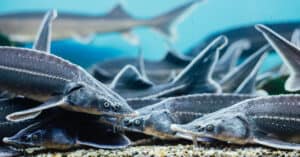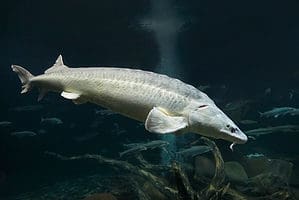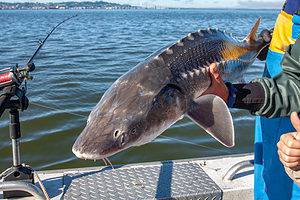Georgia is the 24th largest state in the United States of America, with an area of 59,425 square miles (153,909 square kilometers). The state is bordered in its southeast region by the Atlantic Ocean. From the ocean floor flows fossils into the coastlines of the U.S. occasionally, unearthing many historic creatures of the world. One of such ancient marvels is the Lake Sturgeon, a fish species that survived even the dinosaur.
Let’s take a look at Georgia’s living dinosaurs.
Sturgeon, the Dinosaur Fish Species
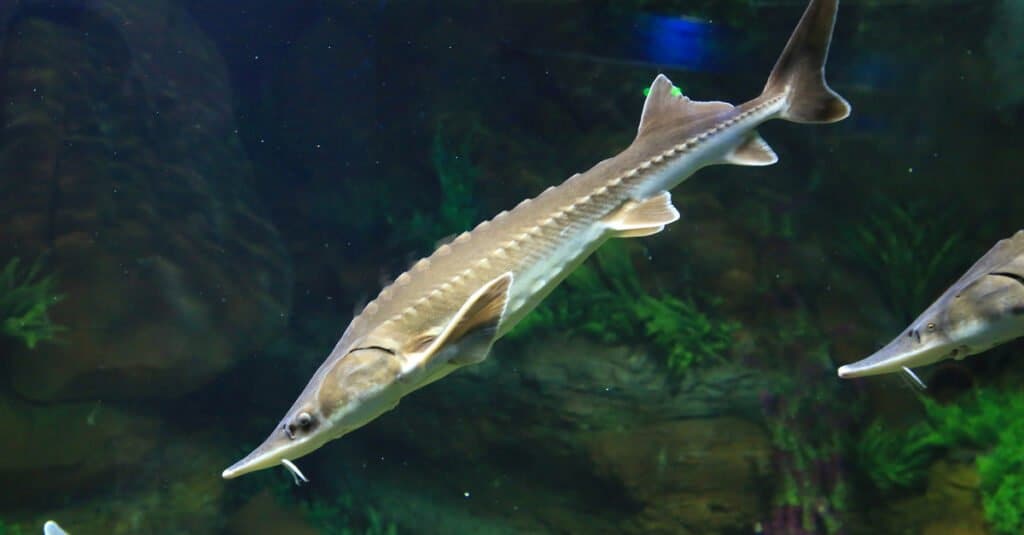
There are 27 species of sturgeon worldwide.
©Geermy/Shutterstock.com
According to Georgia’s Department of Natural Resources, there are 27 species of sturgeon worldwide. About 8 of the sturgeon species live in North America. They are the white sturgeon, green sturgeon, shortnose sturgeon, pallid sturgeon, Alabama sturgeon, shovelnose sturgeon, gulf sturgeon, and lake sturgeon. These ancient fish grow to large sizes, up to 9 feet (2.74 meters) long, and can weigh between 150 to 300 pounds (68.04-136.08 kilograms). They have been known to grow to much bigger sizes, like the Beluga sturgeon, which can weigh over 3,000 pounds (1360.78 kilograms).
Sturgeons have been on Earth for around 200 million years, surviving even the dinosaurs with whom their ancestors shared the planet. This fish species has evolved over the years but still keeps a prehistoric look. Sturgeons have bony plates over their skin instead of scales like most fish.
They also have a longer lifespan than most other fish species, living up to 100 years old. Sturgeons do not have teeth but suck in food from the sandy and rocky bottoms of their freshwater habitats.
Lake Sturgeon, The Living Dinosaurs of Georgia

The lake sturgeon is the largest freshwater fish in North America.
©Fabien Monteil/Shutterstock.com
Lake sturgeon (Acipenser fulvescens) is the largest freshwater fish in North America. This large fish can grow over 7 feet (2.13 meters) long and has a heavy body weight. The world’s largest recorded lake sturgeon was reeled out of Lake Michigan, weighing over 300 pounds.
This ancient fish species has a distinctive look likened to an armored torpedo. Lake sturgeon have dark or greenish-gray colors, with a lighter belly and long snouts with barbels that dangle from them. They, however, share a similarity with sharks, having partly cartilaginous tails.
Male lake sturgeon live up to 55 years, while females live as long as 150 years. The males fully mature sexually between 8 and 22 years, while the females mature between ages 14 and 33. These marine creatures mostly stay at the bottom of their freshwater habitats unless it is spawning season.
Where are Lake Sturgeon Found?
Lake sturgeons are endemic to North America. These freshwater dinosaurs are mostly found in the Great Lakes. There are reports of over 30,000 lake sturgeon in the region that extends from Hudson Bay to the Mississippi River in the south. They can also be found in other water sources on the continent, including the Coosa River in Georgia.
What Do Lake Sturgeon Eat?
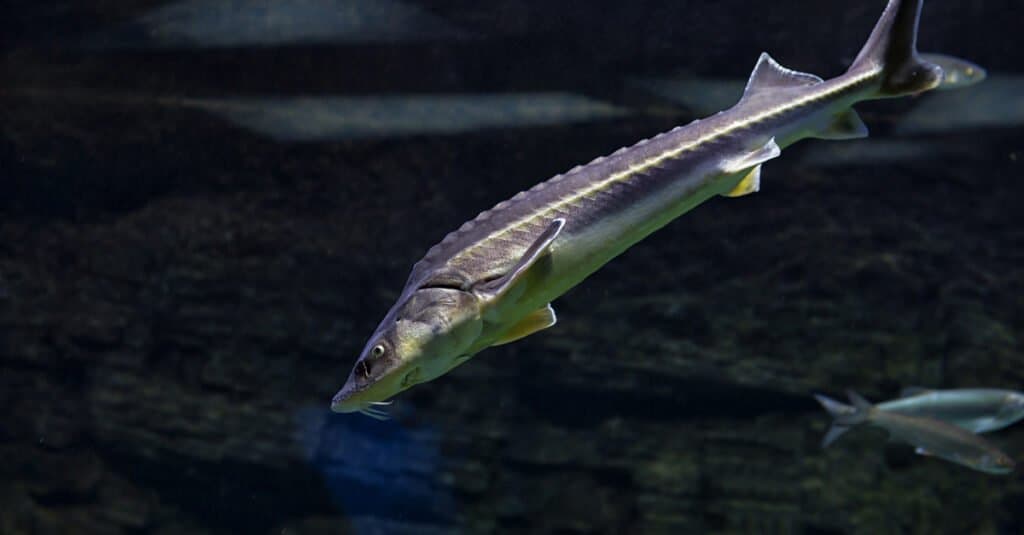
Lake sturgeon prey on small animals such as worms, leeches, mollusks, insect larvae, clams, and amphipods.
©Galina Savina/Shutterstock.com
Despite the lack of teeth, this Georgian fish is carnivorous, feeding by sucking in small prey like a vacuum. The deep water species have sensitive barbels that act as electroreceptors to help them find prey at the bottom of the lake where they often live.
Some animals that serve as prey to lake sturgeon include worms, leeches, mollusks, insect larvae, clams, and amphipods. Despite the abundance of prey for the large fish, these slow-feeders have been known to survive weeks without eating. Lake sturgeon have no known predators in their habitat other than the lamprey, which attach themselves to the large fish and make holes to suck the sturgeon’s body fluids.
How Do Lake Sturgeon Reproduce?
Lake sturgeon have interrupted breeding cycles, sometimes not breeding for up to four years. Their odd reproduction pattern and slow sexual maturity are some of the reasons that the ‘living dinosaurs’ are hard to find in some parts of the United States.
These deep-water fish hardly come up to the surface except while hunting or during the breeding season. This period usually lasts between April and June, with the large fish migrating toward lake shores and fast streams with pebbly bottoms where the water temperature is between 55 to 64 degrees Fahrenheit (12.78-17.78 degrees Celsius).
The female lake sturgeon would lay between two million to three million eggs which a mature male would fertilize externally. Both adult lake sturgeon then leave the eggs behind. A ball of jelly around the eggs keeps them from getting carried away by the water currents around them.
Why Do Lake Sturgeon Jump?
Like most sturgeon species, lake sturgeon have been spotted leaping out of the water and landing with a splash. They can leap more than 6 feet (1.83 meters) out of the water before disappearing again. Besides the striking beauty of the fish’s performance, it is quite an odd behavior, as many fish that leap out of water are often speedier surface-dwelling fish. Lake sturgeon is the opposite; larger and a bottom dweller, yet it leaps vertically into the air and falls on its side.
Scientists, anglers, and many others have come up with different theories to explain the action of these majestic creatures. Some of the theories are:
- Lake sturgeon leap out of the water to shake off leeches and other parasitic creatures.
- They leap when they are startled.
- According to the New York Times, a group of Florida scientists suggested that sturgeons might leap out of the water to communicate with one another.
- Lake sturgeon leap out of the water because it feels good.
- Lake sturgeon leap out of water because crustaceans scratch the inner walls of their bellies.
Studies are ongoing to provide a scientifically proven answer to the mystery behind the lake sturgeon’s mighty leap. However, it’s also possible that they leap into the air because they can and like to show off.
What the Return of Lake Sturgeon Means for Georgia’s Ecosystem
According to CBS News, scientists and students in Georgia were thrilled when three female sturgeon were found in a Georgia lake with mature eggs, and it marked the first time in 50 years that the species had spawned in the state.
According to the Wildlife Resource Division of Georgia, lake sturgeon became locally extinct in the Coosa River, northeast of Georgia, in 1960. The WRD commenced efforts to restore the species to the river in 2002. Scientists believe that overfishing and pollution have contributed to the near-extinction of the unique freshwater species.
However, the return of lake sturgeon will have little to no impact on Georgia’s ecosystem. Lake sturgeon hardly feed on fish and would not deplete the state’s fish population. They also do not reproduce so often that they would overpopulate the lakes any time soon.
Are Lake Sturgeon Endangered in North America?
According to Minnesota’s Department of Natural Resources, lake sturgeon are considered endangered, threatened, or species of special concern in 19 states in America. However, the living dinosaurs are locally extinct in Arkansas, Alabama, and Louisiana. Anglers are often advised to put lake sturgeon back into the lake when reeled in from the water to conserve them.
However, lake sturgeons are still in danger of pollution, climate change, falling water levels, invasive marine species, etc.
Up Next…
The Largest Sea Dinosaur in History
The photo featured at the top of this post is © Kletr/Shutterstock.com
Thank you for reading! Have some feedback for us? Contact the AZ Animals editorial team.



